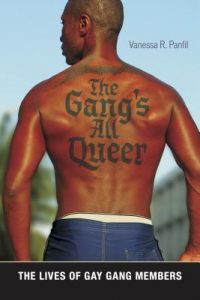 The Gang’s All Queer: The Lives of Gay Gang Members
The Gang’s All Queer: The Lives of Gay Gang Members
by Vanessa R. Panfill
New York University Press
289 pages, $28.
THE KIDS loved going AWOL every now and then from their group home. Sometimes singly, or more often in pairs, some boys would take off after school on Friday and head to nearby Hollywood. They would meet up with other gay youth and young adults (mostly runaways or homeless) to turn tricks, shoplift some clothes and snacks, get high, and party. The “fishy” boys (their term for the effeminate ones) or “transies” (their slang for transgenders) would meet up with their trans “mothers” for guidance on passing as a woman, hormones, silicone augmentation of breasts and hips, and managing sex work. Even though many had experienced dangers—including arrests, muggings, kidnappings, threats with weapons—the thrill of independence, risky sex, and life in the fast lane was often too alluring to give up. The adults they met on the street—the trans sex workers, the hustlers, the pimps—were role models of fun, freedom, self-sufficiency and fierceness.
I saw the kids the next week (or after a few months in juvenile hall) when they returned on their own or were brought back by the police. I was one of two child psychiatrists working at a non-profit agency dedicated to LGBT adolescents in six group homes for minors and in transitional-living apartments for young adults. Demographically, the vast majority came from low income, inner-city Latino and African-American families. This was not the Hollywood Glee version of cute gay kids with gumption. These were LGBT kids who had been abused, neglected, or abandoned. Like other traumatized kids, they could be defiant, rude, loud, and fighting constantly—with staff, teachers, family, school peers, but mostly among themselves. A sideways glance, an unacknowledged greeting, or flirting with someone else’s boyfriend could instantly lead to screaming, scratching, and a full-blown cat fight, to the delight of their peers.
So it was with a sense of wry nostalgia that I anticipated reading Vanessa Panfil’s The Gang’s All Queer: The Lives of Gay Gang Members. Unless inner-city gay youth are vastly different in Columbus, Ohio, from those in Los Angeles, I expected to hear some familiar stories. Overall, Panfil did not disappoint, as she let her informants give voice to their lives and concerns.







